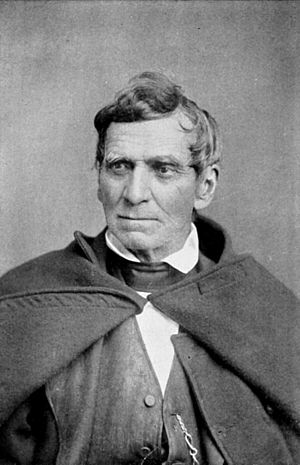Lindsay Applegate facts for kids
Quick facts for kids
Lindsay Applegate
|
|
|---|---|
 |
|
| Member of the Oregon House of Representatives | |
| In office 1862–1863 |
|
| Constituency | Jackson County |
| Personal details | |
| Born | September 18, 1808 Kentucky |
| Died | November 28, 1892 (aged 84) Klamath Falls, Oregon |
| Political party | Republican |
| Spouse | Elizabeth |
| Occupation | Indian agent |
Lindsay Applegate (born September 18, 1808 – died November 28, 1892) was an American pioneer. He is famous for helping to create the Applegate Trail. This trail was a new, safer path that branched off the main Oregon Trail. Lindsay worked on this trail with his brothers, Charles and Jesse, starting in 1846.
Contents
Early Life and Family
Lindsay Applegate was born in Kentucky on September 18, 1808. His parents were Daniel and Rachel Applegate. In 1820, his family moved to Missouri and became farmers.
In 1831, Lindsay married Elizabeth Miller. They had six sons together. Lindsay also took part in a conflict called the Black Hawk War in 1832.
Journey to Oregon Country
In 1843, Lindsay and his brother Charles traveled to the Oregon Country. Their younger brother Jesse also came along. They sold their farms in Missouri and bought many cattle for the journey.
At that time, the Oregon Trail was still new. The last part of the journey was very dangerous. Travelers had to go by boat on the Columbia River. The river had strong winds, fast rapids, and swirling water.
Sadly, Lindsay's nine-year-old son Warren died in the river. Jesse's ten-year-old son Edward also drowned. Because of these tragedies, Lindsay decided to find a better and safer way for future travelers. Other accidents in the following years made more settlers want a new route.
Lindsay and fourteen other settlers then created the South Emigrant Trail. This new path went from Fort Hall in Idaho to the Willamette Valley in Oregon. It passed through northern Nevada and southern Oregon. The goal was to make the journey safer. It also helped settlers avoid areas controlled by the British.
Creating the Applegate Trail
Jesse Applegate learned about another trail, the California Trail, from the Hudson's Bay Company. This trail went from Idaho to northern California. Combining this knowledge with local trapper trails, fifteen men set out in June 1846. The government of Oregon supported their expedition.
They traveled south through several valleys in Oregon. Then, they turned east and crossed the Cascade Range. They went around Upper Klamath Lake and reached what is now Winnemucca, Nevada. The group then split up. Some rested, while others continued to Fort Hall. The first group of settlers to use the Applegate Trail followed the Applegate party on their return trip in the fall of 1846.
When the group returned, they started to clear a path for wagons. However, they were not fully prepared. They had few tools and were very tired. An early winter also made things harder. This was the same winter that trapped the Donner Party in the Sierra Nevada mountains.
By the time they reached the Rogue Valley, winter had fully arrived. Rain, snow, mud, and swollen rivers made travel difficult. They also had low supplies and little food. Relief parties from the Willamette Valley eventually helped them.
Some people blamed the Applegates for the hardships the first wagon train faced. This led to many arguments. Even though the Applegate Trail tried to avoid natural dangers, conflicts with Native American groups caused many deaths. By 1862, at least 300 settlers died along the trail. The trail was not used much after 1847.
Lindsay Applegate and his group were the first white men to explore what is now the Lava Beds National Monument. They found it hard to cross the rough lava fields near Tule Lake. A natural crossing called Stone Bridge helped many settlers pass through.
Later Life and Work
In 1846, Lindsay Applegate claimed land in Yoncalla, Oregon. He built a grist mill there. He was also a carpenter and built the first river ferry in Polk County, Oregon in 1844. He owned a toll road through the Siskiyou Mountains for a while.
In 1861, Lindsay was appointed as a special agent for the Modoc Native Americans. In 1862, he was elected to the Oregon House of Representatives. He represented Jackson County, Oregon as a Republican. In 1865, he became an Indian subagent. This meant he helped with treaties and dealings between the U.S. government and the Klamath Native Americans.
Lindsay retired in 1869 and moved to Ashland. The Modoc War began shortly after he retired. In 1873, Lindsay and other settlers suggested forming a peace commission. This helped to stop the war from spreading.
Lindsay Applegate died on November 28, 1892. He passed away in either Klamath Falls or Ashland. He was survived by several of his children. His wife, Elizabeth, had died in 1882.
Applegate wrote a book about his experiences called Notes and Reminiscences of Laying Out and Establishing the Old Emigrant Road into Southern Oregon in the Year 1846. The Applegate River in Oregon is named after him.
Images for kids


